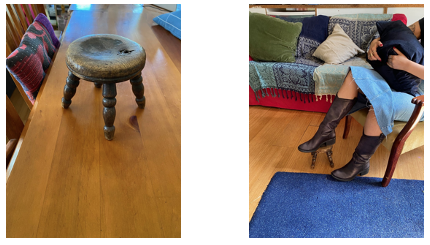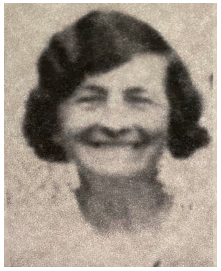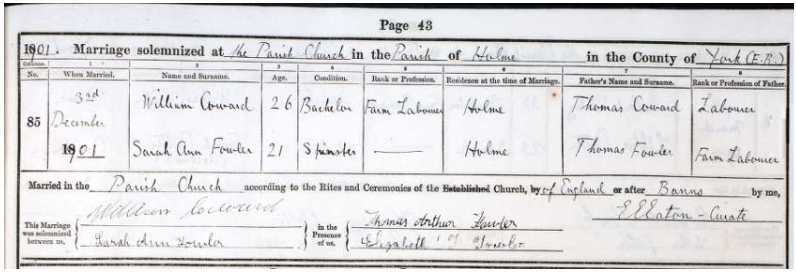Margaret Tucker was born in Selby in Yorkshire and she emigrated to Australia in the 1960s, first to the steel milling town of Whyalla, in the desert of northern South Australia, then to the much milder capital city of Adelaide. She brought with her a nursing footstool that had belonged to her grandmother, Sarah Fowler, who had been a midwife for the towns and villages around Selby in the 1910’s and 20s.

It is a tiny little wooden stool about 10cm high and it is used to lift the mothers leg a little so she can more easily support the head of the feeding baby. I originally thought this was going to be a family history of a lineage of midwives in North Yorkshire, but instead it’s a story about a clever and entrepreneurial working-class woman trying her hand just after the First World War.
Margaret’s grandmother was Sarah Ann Fowler, and she was born 5 December 1880. She died in 1945.

She married William Cawood 3 December 1901 in the parish church at Holme-on-Spalding Moor, Yorkshire. He was 26, a farm labourer. She was 21. The witnesses were Sarah’s parents, Thomas and Elizabeth Fowler

Margaret writes
“Sarah was a woman of real drive and energy, she had picked up some nursing knowledge which led her to becoming the local midwife and she was often called on by local doctors for deliveries and also for laying out of the dead. She also had her own remedies which she called “Cawoods Home Remedies” which included a rubbing liniment, cough syrup and health salts.”
Here is the recipe for her cough syrup
2 oz Spanish
1 d Laudanum
1 d Panegeric
1 d Oil of Mint
1 d Oil of Aniseed
1 lb Treacle
1 Pint of water
Laudanum of course is opium, sold as a tincture in an alcohol solution. It was an essential medicine in every household through the nineteenth century, as a cough suppressant, to control diarrhea and to help babies sleep! It was apparently extremely bitter to drink, hence the pound of treacle!
We think we have tracked down what “panegeric” is. It might be a medicine called Paregoric, and it gives another dose of opium to go with the laudanum! It seems to have been invented initially in the eighteenth century as “an elixir of honey, licorice, flowers of Benjamin, and opium, camphor, oil of aniseed, salt of tartar and spirit of wine”. Sounds rather nice doesn’t it? Benjamin flowers come from the Benjamin tree, and I found a lovely description from an 1812 edition of John Hill’s Family Herbal.
A BEAUTIFUL tree frequent in the East, and there affording the fine fragrant resin of its name. It is a moderaccly tall tree; the bark is smooth and brown; the leaves are broad, oblong, and not unlike those of the lemon-tree. The flowers are whitish, and very inconsiderable. The fruit is as big as a nutmeg, and consists of a fleshy substance on the outside, and a kernel inclosed in a thin and brittle shell within.
They cut the branches of the benjamin trees, and the juice which flows out hardens by degrees into that reddish and white fragrant resin we see. It is an excellent medicine in disorders of the breast and lungs: and a tincture of it made with spirit of wine makes water milky, and this mixture is called virgins’-milk; it is good to cleanse the skin.
Sarah also produced a home version of an ointment called Zam Buk. Zam Buk is still a brand name in use, a “herbal ointment balm”, so Sarah Fowler might have run foul of the patent laws if she had really made a success of these lines. There is a good chance she did not care in the least! She was healing and helping her community.
Zam Buk (for aches and pains).
1 d Eucalyptus oil
2 d Swallow oil
1 d Bees wax
1 d Vaseline
Dissolve together on oven top and stir until melted.
For “Swallow oil” you will be entertained if you do a quick internet search and find some of the horrific approaches to acquiring this ingredient from the seventeenth and eighteenth centuries (essentially by stomping on actual swallows until they form a paste!). However, someone else has suggested that it refers to “Green Oil” made by steeping bruised elder leaves in linseed oil, which frankly sounds more likely.
I found these advertisements for Zam Buk from the 1930s. You can see they weren’t so precious in talking about pimples, blotches and eczema, but still had room for some glamour even so! Was this the market Sarah Fowler was aiming for? Wikipedia lists the ingredients as paraffin wax, colophony (a resin from pine trees) and eucalyptus oil.

Margaret says that when the UK government introduced a requirement for midwives to have certification, Sarah felt she was “too old to start again and instead she became a home help for women during and after the birth of their babies. This was the time when she would have used the nursing stool to assist her patients”. Certification of midwives began in 1902 and was introduced gradually through to 1910. Sarah may have continued working as a midwife until the introduction of the Midwives Act in 1936.
One interesting thing happened in the course of researching this topic, and that was that a person on a community blog site also said that her great grandmother had left a notebook with a similar recipe for Zam Buk to Sarah’s. My great-grandfather also had a home remedy the family called “Grandads’s stuff” that frightened the children quite a lot.
It seems we were still, even into the 1930’s, in a transition to a fully-fledged industrial consumer economy in health care. Prior to the introduction of the National Health Service in 1948, of course, professional medicine was an expensive option for working-class people in Britain. There was still a space for community based, non-professional medical practices.
Sarah’s great granddaughter Katherine says that the family greatly respected Sarah, not so much as community healer – they would not have used that word – but as a community helper. “They all did it, working for the Church, and for each other.” As for the nursing stool itself, they were all very intrigued by it and it came with them to Australia as a connection to the old times, to their countryside which was such a contrast to the deserts of South Australia, and to their much beloved family.